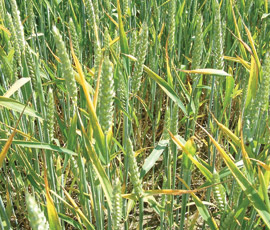Controlling BYDV set to be easier this autumn

Controlling barley yellow dwarf virus (BYDV) this autumn should be less challenging than last year, agree experts, despite the confirmation that grain aphid populations may be carrying resistance to pyrethroids.
That’s because BYDV is transmitted by two aphid species, explains Stephen Foster of Rothamsted Research, who adds that the bird cherry-oat aphid is the more important vector of the two.
“The grain aphid is also an effective vector and it is the species that had kdr-resistance identified last year,” he confirms. “However, testing is continuing to establish how potent this resistance is, as well as how widespread.
“So a knee-jerk reaction to a few positive results would be unwise. Until we know more, the jury’s still out on whether pyrethroids will work.”
Fortunately, there’s no sign of this resistance in the bird cherry-oat aphid, he stresses, so the likelihood is that foliar sprays will be effective against the main aphid vector, providing that timely applications are made and full rates are used.
In the meantime, the cold, wet weather means that grain aphid numbers are lower than usual, he points out. “We haven’t had the migration and rapid build-up of populations that we saw last year, so we are starting from a very different base.”
Grain aphids may be carrying resistance to pyrethroids Aphid numbers are lower this year Seed treatments and full-rate sprays will be effective
Dick Neale, technical manager with Hutchinsons, agrees. “There are nowhere near the aphid numbers that we had in 2011. And don’t forget that crops were drilled early then, which provided the green bridge required by the aphids and contributed to the problem.”
This year, the late harvest means that crops are very unlikely to be drilled early, he points out. “What really undid people last season was that the worst infections came in at quarter to half leaf emergence. Even those crops which had a seed treatment on were only protected for six to eight weeks, so unless they used a follow-up spray, they had a problem.”
This year’s wet weather is helping to create a green bridge again, by allowing grassweeds and volunteers to grow in stubbles, he notes, so there’s no room for complacency when it comes to aphids migrating into newly emerged cereal crops. “If the temperature is above 15C, they will fly in.”
Deter seed treatments are a good idea for two reasons, advises Mr Neale. “They provide up to eight weeks’ protection from the moment the crop comes through and they repel slugs. And slug numbers are very high this autumn.”
New guidelines from the Insecticide Resistance Action Group (IRAG) highlight that only one control failure was reported from Lincolnshire last year, where pyrethroids were used in late June. They also advise that successful BYDV control depends on a number of factors (see Factors affecting BYDV control, above).
If grain aphid is the main aphid pest present, growers should be aware that pyrethroid sprays may not be effective, says Bill Parker, chairman of IRAG.
“If you spray and control is poor, then don’t use another pyrethroid. Switch to an insecticide with an alternative mode of action.”
To do this, he recommends growers consult with their BASIS-qualified agronomists to get the most relevant recommendation.

